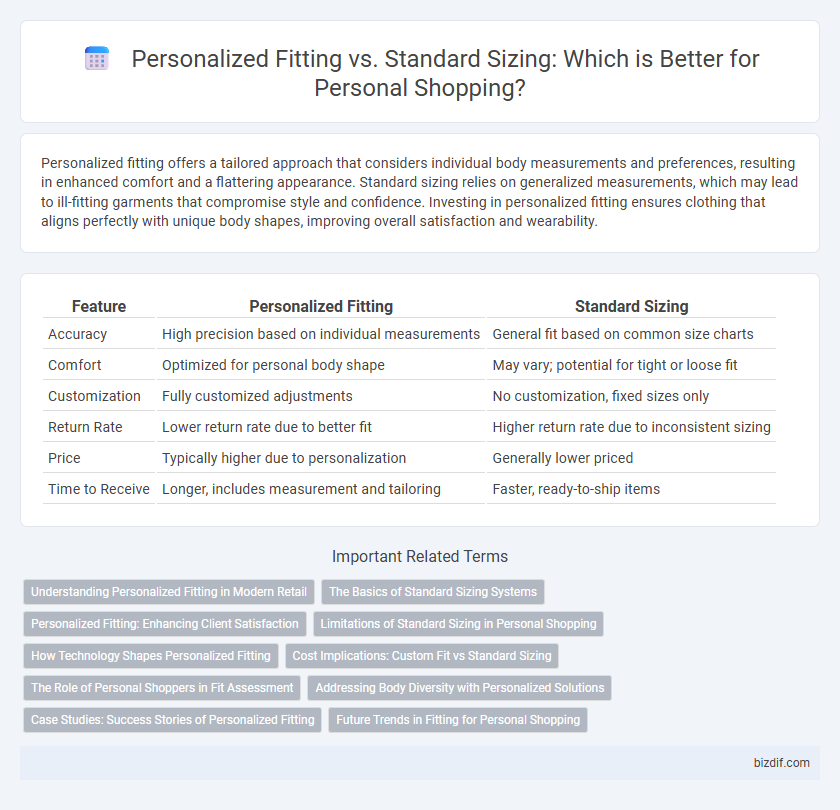Personalized fitting offers a tailored approach that considers individual body measurements and preferences, resulting in enhanced comfort and a flattering appearance. Standard sizing relies on generalized measurements, which may lead to ill-fitting garments that compromise style and confidence. Investing in personalized fitting ensures clothing that aligns perfectly with unique body shapes, improving overall satisfaction and wearability.
Table of Comparison
| Feature | Personalized Fitting | Standard Sizing |
|---|---|---|
| Accuracy | High precision based on individual measurements | General fit based on common size charts |
| Comfort | Optimized for personal body shape | May vary; potential for tight or loose fit |
| Customization | Fully customized adjustments | No customization, fixed sizes only |
| Return Rate | Lower return rate due to better fit | Higher return rate due to inconsistent sizing |
| Price | Typically higher due to personalization | Generally lower priced |
| Time to Receive | Longer, includes measurement and tailoring | Faster, ready-to-ship items |
Understanding Personalized Fitting in Modern Retail
Personalized fitting in modern retail leverages advanced body scanning technology and AI-driven algorithms to deliver clothing tailored precisely to individual measurements, ensuring optimal comfort and style. Unlike standard sizing, which relies on generalized size charts, personalized fitting minimizes fit issues and returns, enhancing customer satisfaction and loyalty. Retailers adopting this approach gain competitive advantage by offering a customized shopping experience that aligns with evolving consumer expectations.
The Basics of Standard Sizing Systems
Standard sizing systems categorize clothing into generalized measurements such as small, medium, large, or numerical sizes based on average body dimensions. These sizes offer a convenient, consistent framework for mass production and retail distribution but often fail to accommodate individual body variations. Understanding the limitations of standard sizing highlights the value of personalized fitting, which enhances comfort and style through tailored measurements.
Personalized Fitting: Enhancing Client Satisfaction
Personalized fitting significantly improves client satisfaction by offering tailored measurements that accommodate unique body shapes and preferences, resulting in better comfort and appearance. Unlike standard sizing, which uses generic dimensions that often lead to ill-fitting garments, personalized fitting ensures each piece matches the individual's exact proportions. This customization reduces returns and enhances the overall shopping experience, fostering greater brand loyalty and repeat business.
Limitations of Standard Sizing in Personal Shopping
Standard sizing in personal shopping often fails to accommodate individual body variations, leading to poor fit and discomfort. This one-size-fits-all approach overlooks factors such as body shape, proportions, and personal preferences, resulting in increased returns and dissatisfaction. Personalized fitting offers a tailored solution by using precise measurements and style customization to enhance comfort and confidence.
How Technology Shapes Personalized Fitting
Advanced body scanning technology and AI algorithms enable precise measurements that tailor clothing to an individual's unique body shape, enhancing comfort and style compared to standard sizing. Digital fitting rooms and virtual try-on tools use real-time data to adjust garment patterns, reducing returns and improving customer satisfaction. This technology-driven personalization revolutionizes the shopping experience by delivering perfectly fitted apparel quickly and efficiently.
Cost Implications: Custom Fit vs Standard Sizing
Personalized fitting often entails higher upfront costs due to custom measurements and tailored adjustments, resulting in garments that offer superior comfort and better wearability. Standard sizing benefits from mass production economies, making these garments more affordable but potentially less precise in fit, which may lead to additional alteration expenses over time. Investing in personalized fitting reduces the likelihood of returns and alterations, ultimately providing better value despite the initially higher price point.
The Role of Personal Shoppers in Fit Assessment
Personal shoppers play a crucial role in personalized fitting by assessing clients' unique body shapes and preferences, which standard sizing often fails to address. They use precise measurements and style expertise to recommend garments that enhance comfort and confidence. This tailored approach reduces returns and improves satisfaction by ensuring a perfect fit beyond generic size charts.
Addressing Body Diversity with Personalized Solutions
Personalized fitting leverages advanced body measurement technology to accommodate unique body shapes and sizes, ensuring a more accurate and comfortable fit compared to standard sizing. This approach addresses body diversity by customizing garments to individual proportions, reducing issues like ill-fitting clothes and enhancing customer satisfaction. Emphasizing personalized solutions transforms the shopping experience, promoting inclusivity and minimizing returns due to sizing discrepancies.
Case Studies: Success Stories of Personalized Fitting
Personalized fitting has revolutionized personal shopping by significantly improving customer satisfaction and reducing return rates, as demonstrated in case studies from leading apparel brands like Stitch Fix and Indochino. These brands report increased sales and higher customer loyalty through tailored measurements that address individual body shapes, enhancing comfort and style. Data shows customers using personalized fittings experience a 30% higher retention rate compared to those purchasing standard sizing.
Future Trends in Fitting for Personal Shopping
Advancements in 3D body scanning and AI-driven measurements are revolutionizing personalized fitting by providing precise, tailored garment recommendations that surpass standard sizing limitations. Virtual fitting rooms and augmented reality tools enable shoppers to visualize clothing on accurate digital avatars, enhancing fit accuracy and customer satisfaction. Integration of wearable technology data promises future trends where dynamic size adjustments and adaptive clothing designs respond to individual body changes in real-time.
Personalized fitting vs Standard sizing Infographic

 bizdif.com
bizdif.com